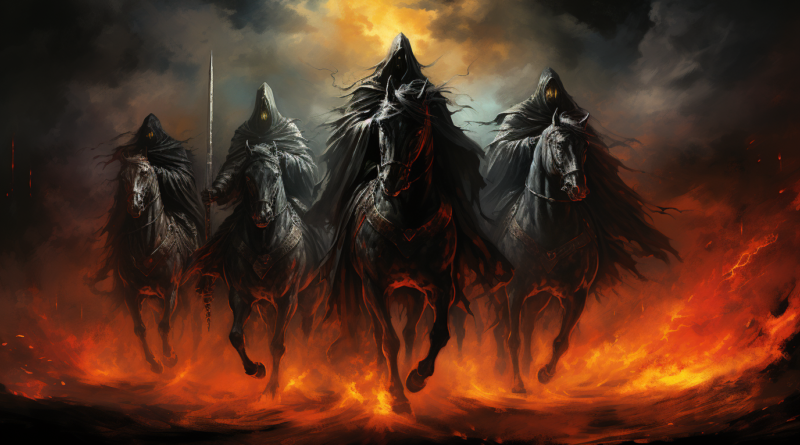The Four Horsemen of the Apocalypse
Ah, the Four Horsemen of the Apocalypse – they’ve graced more Hollywood screens and novel pages than we could count, haven’t they? But do we truly understand who these enigmatic figures are? If your answer’s a “not quite,” then you’re in the right place! Sit back, and let’s explore this fascinating, if somewhat daunting, biblical topic.
Our story starts in the last book of the New Testament, aptly named Revelation. It’s a bit like the final act in a dramatic play, full of symbolic language and prophetic visions. So, prepare for a bit of a mind boggle as we delve into Revelation 6:1-8. Here, we meet our equestrian quartet, each appearing as a seal – not the cute sea-dwelling kind – but a seal of a scroll is opened.
The First Horseman rides in on a white horse. He’s armed with a bow and is given a crown. Now, white usually brings to mind peace and purity, right? Not quite the case here. This chap is generally considered to represent conquest. You see, in the time the Bible was written, a conquering king would ride a white horse. So, this horseman, with his bow and crown, suggests a conqueror, someone keen on dominating others. It’s a bit like when your favourite football team sweeps the board, only much more serious!
Then comes the Second Horseman, charging in on a fiery red horse, wielding a big sword. Red often symbolises war and bloodshed, and this horseman fits the bill. He’s given the power to take peace from the earth, causing people to kill each other. A bit like when tempers flare at a quiet family game night, only on a much, much larger scale.
The Third Horseman enters on a black horse, carrying a pair of scales. Now, these aren’t the type you’d use to whip up a batch of scones. These scales symbolise famine and economic disparity. The mention of wheat and barley prices – but the protection of oil and wine – suggests a time when basic food supplies will be costly, while luxury items remain untouched. It’s like popping to the shops for bread and milk, only to find their prices skyrocketing, while the champagne’s still on offer.
Finally, the Fourth Horseman arrives, riding a pale horse. He’s accompanied by Hades (the realm of the dead) and has the grim task of bringing death through sword, famine, plague, and wild beasts. This pale rider represents mortality and the inevitability of death. It’s a sobering reminder that life on earth has an expiration date.
Now you might be asking, why are these horsemen mentioned? What’s the point of all this gloom and doom? Well, remember, Revelation is apocalyptic literature, intended to unveil deep truths about human life and destiny. These horsemen aren’t just there to add a touch of drama; they’re symbolic representations of the hardships and calamities that occur in our world. They’re reminders of the consequences of human sin – war, economic injustice, death, and conquest.
However, it’s not all doom and gloom. Amidst these vivid, unsettling visions, there’s a beacon of hope. The book of Revelation may highlight the troubles of the world, but it also proclaims the ultimate victory of God. It promises that these trials and tribulations aren’t the final act; there’s a glorious conclusion where God will mend what’s broken and wipe away all tears.
So, while the Four Horsemen of the Apocalypse might seem daunting, they serve as stark reminders of the world’s struggles, while also pointing to the hope and victory found in God. The next time you come across them in a movie or a book, you’ll know there’s more to these riders than meets the eye – a message of truth, warning, and ultimately, hope.


It would appear that these Americans have an understanding of Jesus closer to that of his original Jewish followers than to the later more esoteric high Christology embodied by the Trinity.
Good for them, I say.